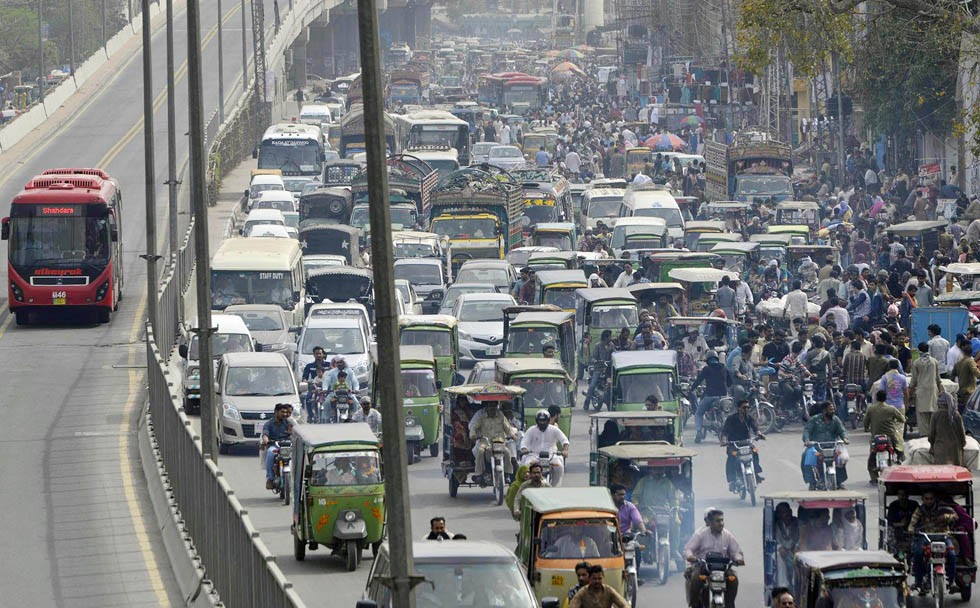
What makes our traffic as bad as it is? It’s the person in the driving seat

There you are, driving along at an easy pace. You’re on time for an important meeting. But slowly the traffic starts piling up. You turn up the air conditioner a notch and trudge further, and are soon engulfed in a 360-degree traffic jam.
It’s not just cars. Motorbikes and bicycles, rickshaws and donkey carts, are all there, and they’re all honking, hoping that somehow the collective din being raised will somehow unravel the fine mess they are in.
A traffic warden casually strolls from across the road to inspect the problem at hand. At the heart of the matter are two vehicles -- one is going the wrong way on a one-way street, and the other is trying to come from the left lane into the right, 10 metres before the traffic signal. Both are now head to head, and with all the other lanes trying to move on their path, they are all packed like sardines in a crushed tin box.
Sounds familiar? Almost everyone who lives in Lahore, Karachi or Peshawar will have felt a little bit of déjà vu from the paragraph above, a feeling of yeah, I’ve been there.
In Lahore’s case, this really shouldn’t be happening. We have all these new wide roads, and brand new coppers, in brand new uniforms. We have cameras and lane markings. What’s missing then? What makes our traffic as bad as it is?
It’s that person in the driving seat, going the wrong way on a one-way street. It’s that biker weaving through lanes without both a helmet and a regard for life. It’s the man who, not having found parking in the lot, has parked his vehicle on the road. The weakest link, is us.
There are a multitude of reasons why we drive the way we do. A very large section of Pakistani drivers have not undertaken any kind of systematic training before getting their licenses. Yes, there is a system in place -- you apply for a learner’s permit, then after a month, you give a test, which is not only about your driving skills but also about road signs, and only if you pass these two barriers, is a driving license issued.
Did you really go through all this ‘hassle’? Most of us have learnt from our fathers or brothers. I remember learning to drive aged 12 and quickly becoming the road-runner of the family, milk and yogurt, eggs and bread, I was the man. But I got my official license 26 years later. It just seemed so unnecessary.
Which leads us to the next point in licensing. You don’t necessarily need a license to drive anywhere in the world. But if you get caught driving without a license, you are done for. Here, unfortunately, all it takes is a little bit of cash. And although the new traffic wardens were supposed to be corruption-free, being young and educated and what not, that faded away rather quickly, when the force was unable to get pay raises to counter the rising cost of living. Each man has his price. Oops!
And then again, with Lahore’s traffic increasing on a daily basis, there just aren’t enough traffic cops around to manage the whole circus. To cover this and other glaring inadequacies, at least 8,000 cameras have been installed across the city, under the Punjab Safe Cities Authority project. One of its main roles is to ensure that traffic flows smoothly, and that rule violators can be identified.
There are at least two glaring weaknesses here. First, as discussed earlier, is that the traffic violator is unlicensed. So if he is caught, thanks to these fantastic cameras, what will happen? Will he be fined? If so, the fine amount should be large enough to force him to go get a license rather than run the risk of getting hit with the fine again. Or, if he or she is a juvenile, then will the parents/guardians be fined? Can the car be impounded? The key here is to make the punishment indiscriminately larger than the crime. That’s the only way people learn.
But to catch these habitual offenders, the camera needs to identify the car. And it is supposed to do that by the license plates. There is a particular design and size which makes them machine readable. So, what do we do about the fancy license plates that Lahoris like to adorn their vehicles with? Recently, the Excise and Taxation department embarked on a weekly license plate breaking binge every Wednesday, setting up check posts across the city. But as the mercury rose, they disappeared. Everyone is now safe till October.
Let’s assume the number plate is kosher and the camera catches the culprit. The car’s registration details are cross-checked in the system and the owner’s name pops up, along with his CNIC number, which then leads to his home address. Under the soon-to-be-implemented e-challan system, auto generated tickets will be sent to the home addresses of the car owner.
This has another problem. Are the details on the CNIC updated? What if the person has changed houses, or has died. Maybe he or she sold the car, and the ownership wasn’t transferred along? Where will be the buck stop?
In all fairness, efficient traffic management at the state end is linked to at least two major institutions, the Excise and Taxation department and NADRA. If their records aren’t updated then the battle is lost. But then again, it’s not the department’s prerogative to update data, is it?
Once again, this onus falls on the weakest link in our faulty system -- us.